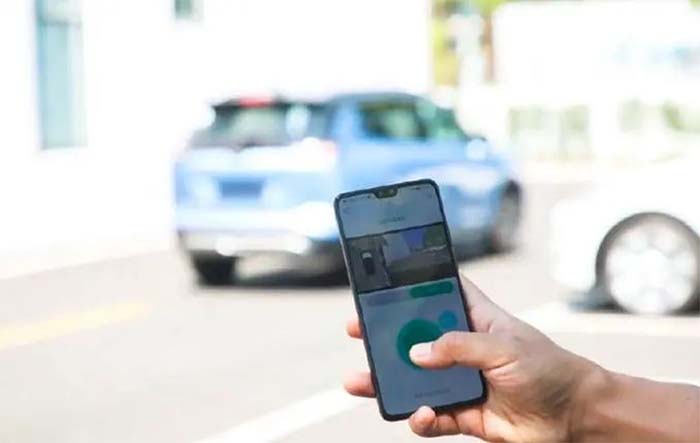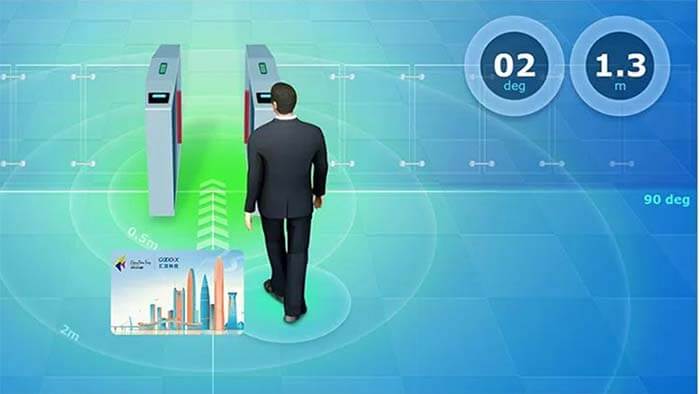With the refined application of NFC UWB technology, people can also realize gate induction and automatic deduction when traveling in the subway.
When it comes to sensorless payment, it is easy to associate with ETC payment – through semi-active RFID communication technology to realize automatic payment of fees for passing the gates of cars.
Recently, Shenzhen bus card platform “Shenzhen Pass” joint Huideng Technology released a subway gate “sensorless offline through the gate” NFC UWB payment program, the program is based on a multi-chip complex RF system, using Huideng Technology “eSE + COS+NFC+BLE” full-stack security solution, and equipped with UWB chip for distance measurement and positioning, secure transactions. Users can pass through the gate with their cell phone or bus card embedded with a UWB chip and automatically know
NFC UWB sensorless payment solution will have NFC UWB and other driving protocols integrated into a low-power Bluetooth SoC chip, through the integration of modular transformation, reducing the difficulty of upgrading the gate, while compatible with NFC gates.
According to the official picture scene published speculation, the UWB base station should be placed at the gate, and the deduction recognition range is within 1.3m. Don’t identify, complete remote gate opening and deduction.
Precise positioning + sensorless payment, NFC UWB will be primarily mobile payment

NFC, Bluetooth, and infrared are the mainstream applications in the field of near-field payment. NFC (near field communication technology) is widely used in mainstream models of cell phones because of its high security and the need for a network power supply, and in Japan and Korea, NFC cell phones can be used for airport boarding verification, building access keys, transportation one card, credit cards, payment cards, etc.
UWB ultra-wideband technology, with ultra-wideband pulse signal (UWB-IR) nanosecond response characteristics, combined with TOF, TDoA/AoA ranking algorithms, including in the line-of-sight (LoS) scenario and non-line-of-sight (nLoS) scenario can achieve centimeter-level positioning accuracy.
IIoTMedia has introduced in detail the applications in indoor precision positioning and digital keys for automobiles in previous articles. With the characteristics of high positioning accuracy, high transmission speed, signal anti-interference, and not easy intercept, this makes NFC UWB in the field of sensorless payment applications have natural advantages.
The principle of sensorless payment through the subway gates is very simple, with the UWB function of cell phones and bus cards, can be regarded as a UWB mobile tag, when the base station monitors the spatial positioning of the tag immediately lock to follow when the preset gate location to open the information interaction, complete the deduction payment action, and then the deduction message from the cloud to the cell phone. The combination of UWB and eSE security chip + NFC can achieve financial-grade security encryption payment.
Another popular application of NFC UWB is the virtual key for automobiles. In the field of automotive digital keys, some mid- and high-end models of BMW, Azera, and Volkswagen have already adopted the “BLE NFC UWB” three-in-one solution, with Bluetooth long-distance sensing waking up UWB for encrypted data transmission, UWB for accurate distance sensing, and NFC as a backup solution for a power failure to realize unlocking control under various distances and power supply conditions. NFC is used as a backup solution for unlocking control under various distances and power supply conditions.
NFC UWB incremental space, success or failure is on the consumer side
However, in the field of industrial IoT, because of the shortcomings and market popularity of Wi-Fi, Zigbee, BLE, and other protocol standards, UWB’s capability is still in high-precision indoor positioning, so the demand in the B-side market is only at the million level, which is relatively fragmented. It is difficult to achieve sustainable investment.
The C-side consumer IoT field, driven by industry demand, has become the main battlefield for NFC UWB. Consumer electronics, smart tags, smart homes, smart cars, and secure payment fields have become key R&D scenarios for companies.
For example, in the fields of sensorless access control, sensorless payment, and smart home, NFC UWB can personalize home settings based on ID information; in the field of consumer electronics, UWB cell phones, and peripheral hardware can be used for indoor positioning, tracking pets, and fast data transmission.
The promotion of NFC UWB sensorless payment, on the one hand, lies in the popularity of cell phones with built-in UWB function in the market, currently only Apple, Samsung, Xiaomi, and VIVO part of models support UWB, there is also OPPO-launched UWB phone case “one key link” program, models and the general public is still relatively limited.
Whether it can catch up with the popularity of NFC in cell phones remains to be seen, to reach the volume of Bluetooth is still a vision. But from the current point of view, NFC UWB into the standard day is not too far away. On the other hand is the endless innovation of high-frequency consumer end scenarios.
NFC UWB for consumer-level tracking, positioning, remote control, and payment is being broadened by midstream manufacturers: Apple’s Airtag, Xiaomi’s One Finger Company, Azera’s digital car key, Huawei’s converged signal indoor positioning, NXP’s ultra-wideband radar, Huitian’s subway payment …… only a variety of innovations that increase the frequency of consumer reach The program is constantly changing, allowing consumers to feel the borderless integration of technology and life, making NFC UWB a word that is enough to break the circle.
Besides this NFC UWB Sensorless Payment article, you may also be interested in the below articles?
What Is The Core 5G NR Technology?




